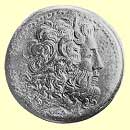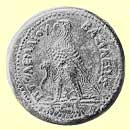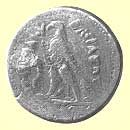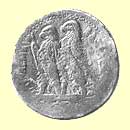As outlined in the introduction, two possible reasons for production of two-eagle coinage have been presented. Introduction
One is that the two eagles indicate a denomination (e.g., a double denomination). The other reason is that the two eagles represent two regents (e.g., two kings, or a king and a queen; co-regency occurred frequently and was always looked upon favorably by the Egyptian populace).
Parts 1 and 1a have shown that denominational marking did not generally occur; denominational marks were not systematically used in the time of Ptolemy III and also apparently not in the time of Ptolemy II. In addition to results from looking at individual sets of denominations (as in Parts 1 and 1a), the review (below) of coins that circulated together gives evidence from hoards that the two eagles were not designed to be denominational indicators.
The two-eagle reverse type was not designed to indicate a double denomination
When two-eagle coinage was first produced (time of Ptolemy II) two eagles as an indicator of a double denomination can readily be ruled out.
For example, the new denominational set produced by Ptolemy II contained no coin of half weight (c.31-39g) that would be the half denomination of his two-eagle coin (denomination B, 62-78g, modular weight c.68g, see coin B above and also see from the table in Part 1 that coins (c.31-39g) that would be the half denomination are absent). No half weight coin was produced (nor were coins of the same weight as B produced with one eagle). It would be, at least, very peculiar to place two eagles on denomination B in order to indicate the doubling of a denomination that was not produced.
There are other aspects that indicate that the double eagles did not denote a double denomination. A half denomination of B (see denomination C Pt III in the table of Part 1a, i.e., 28-38g , modular weight c.34g) was later produced by Ptolemy III. At that time Ptolemy III also produced a denomination (see coin B* above) of twice the weight of C (see denomination A Pt III in the table of Part 1a, i.e., 59-78g, modular weight c.68g). Both coin C of Ptolemy III and its double denomination (i.e., coin B*) produced by Ptolemy III show one eagle. Therefore, the double-eagle reverse type was neither used by Ptolemy III nor, contrary to the suggestion of M. Price, by Ptolemy II to indicate a double denomination.
by Ptolemy II to indicate a double denomination.
Since the two-eagle coin B produced by Ptolemy II and the one-eagle coin B* produced by Ptolemy III are the same denomination the Ptolemaic mint either had an inconsistent system of denominational marking or the different reverse types (one or two eagles) had no denominational significance. Apparently, the two-eagle reverse type was initiated by Ptolemy II, not to indicate denomination, but for some other reason.
Yet this first occurrence (i.e., coin B of Ptolemy II) of two-eagle coinage produced an unusual type with a major difference from all the minor type variations used on the other coins of Ptolemy II; if dual-eagles did not indicate the doubling of a denomination they likely indicated something important and were not just a stylistic variation.
That the two eagles on coins of Ptolemy II did not represent any specific denomination is shown (below) by good hoard evidence.
Other evidence that the two-eagle reverse type was not a denominational marker
When the circulation together of coins from different kings is considered, the evidence from hoards shows that the symbol of two eagles on coins of Ptolemy II did not indicate denomination. The fundamental and universal principle concerning Ptolemaic denominations is that relative denomination (i.e., relative value) is indicated by relative modular weights; this principle is used in all reviews of denominations. This principle would be violated if there were coins in circulation of the same denomination (i.e., same weight module) with two different types that did indicate different denominations. It can reasonably be expected that coins with the same modular weight that circulated together would have the same value.
This principle would be violated if there were coins in circulation of the same denomination (i.e., same weight module) with two different types that did indicate different denominations. It can reasonably be expected that coins with the same modular weight that circulated together would have the same value.
When the two-eagle type is taken as a denomination mark a violation of the weight-denomination principle occurs with the two-eagle coins of Ptolemy II. As shown by the Newell hoard , coins of Ptolemy II′s c.68g module B showing two eagles (see B above) circulated with coins of the same denomination with one eagle (c.68g module of Ptolemy III, see B* above). One denomination with two different types (B and B*) circulated at the same time. If one and two eagles indicated different denominations (i.e., different values) then these two coins with the same module but different values would break the same-module same-value relationship. Since coins B and B* have the same modular weight (i.e., same value) their different types (with one- and two-eagles) can not act as denominational indicators of different values.
, coins of Ptolemy II′s c.68g module B showing two eagles (see B above) circulated with coins of the same denomination with one eagle (c.68g module of Ptolemy III, see B* above). One denomination with two different types (B and B*) circulated at the same time. If one and two eagles indicated different denominations (i.e., different values) then these two coins with the same module but different values would break the same-module same-value relationship. Since coins B and B* have the same modular weight (i.e., same value) their different types (with one- and two-eagles) can not act as denominational indicators of different values.
It is still possible that the two eagles on Ptolemy II′s coins B were decreed (by Ptolemaic authorities) to indicate that this type of coin should be given a different value over coins B* in the market place. However, this is a very unlikely possibility when the Egyptians were otherwise used to the relative-weight relative-value principle that applied to all their other bronze coinage. [ Can't you just image the vigorous incredulity and friendly argument when a shopper in the ancient Egyptian marketplace asked for, say, twice the goods for a coin of Ptolemy II (showing twice the number of eagles) than for the corresponding coin of the reigning king Ptolemy III (with one eagle)?! ]
These coins of Ptolemy III and of Ptolemy IV circulated together in the 3rd century BC |
 B* B* | |  B** B** |
Coin of Ptolemy III (246 - 221 BC)
c.68g module (one eagle) | Coin of Ptolemy IV (221 - 204 BC)
c.68g module (one eagle) |
| |
As illustrated (left), coins B* of Ptolemy III of the c.68g module with one eagle circulated together with c.68g one eagle coins B** (right) produced by Ptolemy IV (221 - 204 BC); such coins were found together in the Getty hoard. As shown above (i.e., top), Ptolemy III′s one eagle coins B* of module c.68g also circulated with the c.68g module two-eagle coins B of Ptolemy II.
As shown above (i.e., top), Ptolemy III′s one eagle coins B* of module c.68g also circulated with the c.68g module two-eagle coins B of Ptolemy II.
Thus denomination B was represented during the third century BC by both one- and two-eagle coins (B* and B**, and B; respectively). However, only Ptolemy II placed the symbol of two eagles on his coins; the two-eagle coins of Ptolemy II were a unique type until at least near the end of the 3rd century. It should be concluded that the two eagles had been placed on module B coins of Ptolemy II not to show denomination, but for some other reason (see Part 2) that did not apply to coins of the same denomination produced by Ptolemy III and Ptolemy IV.
However, only Ptolemy II placed the symbol of two eagles on his coins; the two-eagle coins of Ptolemy II were a unique type until at least near the end of the 3rd century. It should be concluded that the two eagles had been placed on module B coins of Ptolemy II not to show denomination, but for some other reason (see Part 2) that did not apply to coins of the same denomination produced by Ptolemy III and Ptolemy IV.
Click go to 1c to see that two-eagle symbolism
also had no denominational significance in the time of Ptolemy VI.

 B
B
 B*
B*
 B**
B**